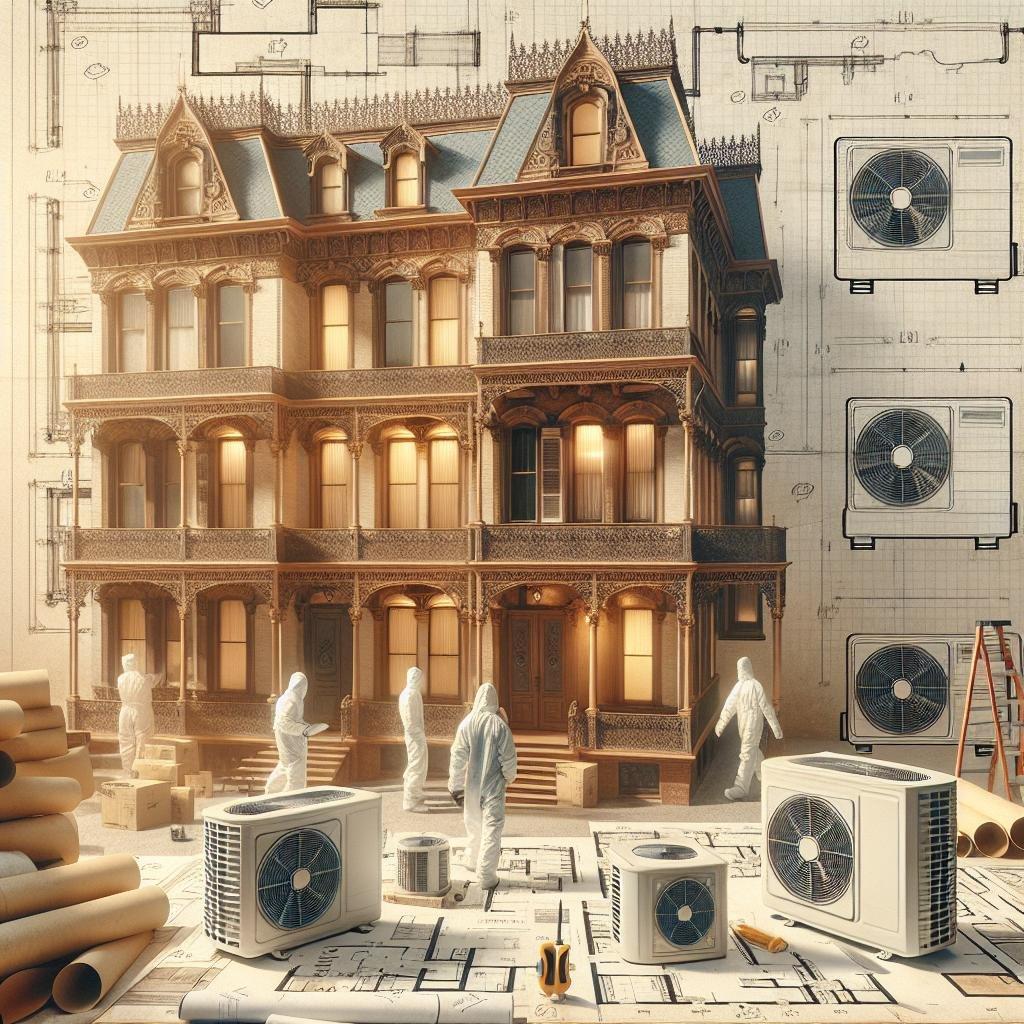In the heart of our cities lie historical buildings that stand as testaments to architectural innovation and cultural heritage. These structures, often adorned with intricate details and timeless charm, tell stories of eras long past. However, as the climate continues to shift and the demand for modern comfort rises, the challenge of maintaining these venerable edifices becomes increasingly complex. Enter the mini-split air conditioning system – a discreet and efficient solution that promises to bridge the gap between preservation and progress. In this article, we will explore the art and science of retrofitting historical buildings with mini-split AC units, uncovering how they can enhance interior comfort while respecting the integrity of the original design. Join us as we delve into best practices, practical tips, and inspiring examples that demonstrate that modernization and preservation can indeed coexist harmoniously.
Understanding the Unique Challenges of Retrofitting Historical Buildings
Retrofitting historical buildings presents a unique set of challenges that require a delicate balance between preserving the integrity of the structure and integrating modern amenities. One primary concern is maintaining the architectural aesthetics, which often involves intricate details that are a significant part of the building’s history. Utilizing mini split AC systems can be a game-changer in this respect, as they offer a ductless solution, eliminating the need for invasive modifications to existing structures. This allows homeowners and architects to outfit these spaces with contemporary cooling without compromising their historical charm.
Moreover, implementing modern climate control solutions in historical edifices necessitates a thorough understanding of local regulations and preservation guidelines. Before commencing a retrofit project, it’s essential to conduct a comprehensive evaluation, which includes:
- Assessing the building’s historical significance
- Consulting with preservation experts
- Reviewing local building codes and regulations
This careful planning not only secures the building’s legacy but also paves the way for the seamless installation of systems like mini split ACs, ensuring that comfort and history coexist harmoniously.

Selecting the Right Mini Split AC System for Preservation and Efficiency
When retrofitting a historical building with mini split AC systems, choosing the right model requires a delicate balance between preserving aesthetics and maximizing energy efficiency. Historical buildings often feature unique architectural elements, which means that the placement and design of mini split systems should be carefully considered. Look for slim and discreet units that can blend seamlessly with the existing decor, as well as those with low-noise levels to maintain the serene atmosphere of the space. Opt for systems that offer advanced features such as inverter technology, which allows the AC to adjust its cooling output based on the needs of the space, ensuring optimal performance while minimizing energy consumption.
In addition to aesthetic consideration, efficiency ratings of the chosen mini split AC systems must align with both the environmental goals and budget constraints. Evaluate options based on the Seasonal Energy Efficiency Ratio (SEER) and Heating Seasonal Performance Factor (HSPF) to ensure you’re selecting from high-performance units that can maintain comfort without excessive energy use. Here’s a quick comparison table of efficiency ratings to help you make an informed decision:
| Model Type | SEER Rating | HSPF Rating |
|---|---|---|
| Basic Model | 15 | 8.5 |
| Mid-Range Model | 20 | 10 |
| Premium Model | 25+ | 12 |
By focusing on these elements, you ensure that the installation of mini split AC systems in historical buildings not only meets modern cooling demands but also respects the charm and integrity of the property.

Integrating Mini Split Technology with Architectural Integrity
When retrofitting a historical building with modern amenities, maintaining the architectural character of the structure is crucial. Mini split systems provide an innovative solution that allows for efficient cooling without compromising the integrity of historical aesthetics. By utilizing discrete indoor units, which can be installed in less visible areas, you can ensure that the original design motifs and architectural features remain untouched. Achieving a balance between modern functionality and historical preservation is key—crafting a plan that respects the building’s legacy while introducing the comfort of contemporary cooling systems is essential.
It’s important to consider specific design elements during the installation process. Here are a few suggestions to harmonize mini split technology with the unique features of your historical building:
- Choose low-profile units: Select models with a compact design that blends seamlessly into architectural spaces.
- Utilize creative placements: Install the indoor units in closets or other non-intrusive locations to mask visibility.
- Respect original features: Ensure that ductwork and electrical lines are routed in ways that maintain the look and feel of the period.
Additionally, understanding the implications of different mini split systems can guide your choice:
| System Type | Pros | Cons |
|---|---|---|
| Ductless Mini Splits | Efficient, easy to install. | Visible indoor units may alter aesthetics. |
| Multi-Zone Systems | Customized cooling for each area. | More complex installation. |
Incorporating state-of-the-art cooling while being sensitive to a building’s historical value showcases a commitment to both past and present. Sustainable solutions like mini splits can transform the living environment without compromising the beauty of architectural heritage. Ultimately, the goal of such integration is to foster a harmony between honoring history and embracing modern technology, creating spaces that are not only livable but also resilient.

Best Practices for Installation and Maintenance in Historical Contexts
Retrofitting a historical building with modern cooling systems like mini-split AC units requires a balance between functionality and preservation. It is crucial to approach installation with sensitivity to the building’s architectural integrity and historical value. To ensure this balance, consider the following guidelines:
- Evaluate the Building’s Historic Character: Understand the significance of various architectural features so that installation minimizes the visual impact.
- Use Concealed Installations: Where possible, install units in less visible locations like attics or utility rooms, and use ductless options that require minimal alteration to existing structures.
- Preserve Original Materials: Avoid damaging original walls or ceilings during installation; use existing frameworks when feasible.
- Consult Preservation Guidelines: Adhere to local and national preservation standards and guidelines to avoid potential legal issues.
Maintaining mini-split systems within historical contexts also necessitates careful consideration of service protocols. Regular maintenance not only prolongs the life of the equipment but also protects the integrity of the building. Useful practices include:
| Main Task | Recommended Frequency |
|---|---|
| Check Filters | Monthly |
| Inspect Drain Lines | Every 3 Months |
| Professional Inspection | Annually |
| Clean Exterior Units | As Needed |
By following these best practices for both installation and maintenance, one can achieve modern comfort while respecting the past, ensuring that historic buildings continue to tell their unique stories within a comfortable environment.
Q&A
Q&A: How to Retrofit a Historical Building with Mini Split AC for Modern Cooling
Q: What is the primary benefit of using a mini-split AC system in a historical building?
A: Mini-split AC systems offer the distinct advantage of being highly efficient while requiring minimal alteration to the building’s existing structure. These systems consist of indoor and outdoor units connected by refrigerant lines, which can be discreetly installed without compromising the historical integrity of the building.
Q: Are there any concerns regarding the installation of these systems in historical structures?
A: Absolutely, the installation of mini-split systems in historical buildings must be approached with care. It’s essential to consider local preservation laws, which may require permission before making changes. Additionally, the choice of installation locations for both the indoor and outdoor units should be thoughtful to avoid detracting from the building’s architectural beauty.
Q: How do mini-split systems blend with the aesthetics of a historical building?
A: Modern mini-split units come in a variety of designs, including sleek wall-mounted options that can be painted to match the wall surfaces. This allows them to blend seamlessly into the environment without drawing attention. In some cases, units can even be hidden behind custom cabinetry or partially recessed into walls.
Q: Is it possible to maintain the historical features of the building while installing a mini-split system?
A: Yes, it is possible! By working with skilled contractors who have experience in retrofitting historical buildings, you can ensure that original features such as moldings, windows, and doors remain intact. Proper planning and creativity in the installation process are key here.
Q: What steps should one take before proceeding with the retrofit?
A: First and foremost, conducting a thorough assessment of the building is crucial. This involves reviewing any existing HVAC systems, understanding the building’s layout, evaluating insulation, and consulting local preservation guidelines. Engaging a professional who specializes in historical renovations can be immensely beneficial throughout this process.
Q: How energy-efficient are mini-split systems compared to traditional HVAC systems?
A: Mini-split systems are renowned for their energy efficiency, often achieving higher Seasonal Energy Efficiency Ratios (SEER) than traditional HVAC systems. Their ability to cool specific zones as needed means they can significantly reduce overall energy consumption, which is particularly advantageous in older buildings where energy loss can be a concern.
Q: What are some tips for maintaining a mini-split system in a historical building?
A: Regular maintenance is vital in ensuring optimal performance. This includes cleaning or replacing filters, checking refrigerant levels, and ensuring that the outdoor unit is clear from debris. Additionally, consider scheduling annual professional check-ups to address any potential issues and prolong the life of the system.
Q: Can installing a mini-split AC system improve the value of a historical property?
A: Indeed! When installed correctly, modern amenities such as efficient cooling can enhance the appeal of a historical property, making it more livable and desirable for potential buyers. As long as the installation respects the building’s character and integrity, it can be seen as a valuable upgrade.
Q: Is there anything else to keep in mind when considering this retrofit?
A: Always prioritize communication with any relevant building preservation organizations and obtain necessary permits before undertaking any modifications. Involving a knowledgeable contractor who specializes in both HVAC installations and historical preservation can help you navigate potential pitfalls and achieve a successful retrofit.
The Conclusion
As we conclude our exploration of retrofitting historical buildings with mini split air conditioning systems, it’s clear that integrating modern comfort with architectural heritage is not only possible but also deeply rewarding. This delicate balance of old and new serves not just to preserve history but to enhance the livability of these treasured spaces. By choosing mini split AC units, you can ensure that the character of your building remains intact while providing an efficient, unobtrusive cooling solution.
As you embark on your own retrofit journey, remember that every historical edifice has its own story to tell. With careful planning, respectful installation, and a commitment to maintaining the integrity of the structure, you can breathe new life into these enduring spaces. So, embrace this fusion of past and present—because in the world of restoration, the temperature may rise, but the essence of history will remain cool and collected. Happy retrofitting!

